Tuesday, November 14
This session will cover modeling fracturing stimulation, and modeling distributed facture networks (including natural fractured networks). It will be specifically related to how we can model the improvements in thermal conductivity of the fracture network with novel proppants/fluids with a goal to increase the thermal exchange efficiency in a geothermal well.
Presentations
- Some Challenges for Existing Hydraulic Fracturing Models in EGS Applications
Olga Kresse, SLB - Thermoelastic Fracturing and Buoyancy-Driven Convection – Surprising Sources of Longevity for EGS Circulation
Mark McClure, Resfrac - Conceptual Models of Hydraulic Stimulation
Ahmad Ghassemi, University of Oklahoma
Well duration has a direct impact on well cost and overall project economics. Presentations will address technologies that accelerate the rate of penetration while maintaining a trouble-free wellbore which is key to lowering overall well costs.
Presentations
- Particle Impact Drilling on FORGE
John Schiller, Particle Drilling - Hard Rock is Not The Problem: How to Achieve 85% Improvement Drilling Granite Using Physics-Based Limiter Redesign
Sam Noynaert, Texas A&M University - Geothermal Drilling Optimization by Pro-Active Downhole Vibration Control and Temperature Management
Eric Van Oort, University of Texas at Austin - Overview of Drilling Innovations, and TechnoEconomic Assessment of Superhot Geothermal
Terra Rogers, Clean Air Task Force
Presentations in this session will cover microfluidics, mechanisms that regulate geo-mechanical and flow/transport processes in subsurface energy reservoirs, core/shell proppants, and water-based and waterless fracturing fluids.
Presentations
- Testing of Very High Temperature Proppants
Matt Uddenberg, AltaRock Energy - High Temperature CO2 Activated Fracturing Fluid
Carlos Fernandez, Pacific Northwest National Laboratory
Presentations will cover lessons learned from real life examples of solving problems that have potential application for both geothermal and oil & gas operations.
Presentations
- The Principles Learned Designing the First Deepwater Platform in an 18$/bbl Oil Price Reality
Lance Cook, Sage Geosystems - Magnetic Ranging for Wellbore Intersection to Create a Closed-Loop Geothermal System
Alex Vetsak, Eavor Technologies - Drilling Performance Data from a Geothermal Development with Horizontal Wells
Elliot Howard, Fervo Energy - Insights from Drilling, Completion, and Circulation at the Utah FORGE Complex
John Mclennan, University of Utah
Wednesday, November 15
Challenges in geothermal well construction and operation and the novel approaches to address these challenges will be discussed. Namely geothermal wells pose risks associated with high to ultra-high well temperatures. Additionally, risks stemming from corrosive fluids, lost circulation, and mechanical and thermomechanical stresses may create challenges to cementing geothermal wells. Presentations will cover novel cementing developments and materials, including compositions and methods, to address the aforementioned challenges in the geothermal high temperature and ultra-high temperature environment.
Presentations
- Designing Cement for Geothermal Wells
Krishna Babu Yerubandi, Halliburton - Geothermal Application of Graphene-Cement: Laboratory Thermal Cyclic Loading Durability Evaluation
Mileva Radonjic, Oklahoma State University - Self-Healing Cements for Geothermal Wellbore Applications
Carlos Fernandez, Pacific Northwest National Laboratory - Cement Integrity, from Laboratory to Simuation
Rym Bouchair, CURISTEC - Opportunities to Improve Geothermal Outcomes Through Better Cementing
Daniel Bour, Bour Consulting
The focus of this session is on advancements of technologies, methodologies, and equipment that has or will have an impact on alleviating the complexities of well completions in harsh geothermal and oil and gas environments. Innovative approaches to completion schemes that can be applied to high temperature and high pressure reservoirs will be emphasized.
Presentations
- Advances in Geothermal Stimulation Solutions
Ahmed Zakaria, Baker Hughes - Open Hole Stimulation Technologies for Effective Stimulation in EGS Applications
Yosafat Esquitin, Welltec - Impact of Cooling on Hydraulic Fracture Initiation and Growth from Wells in High Temperature Formations
Andy Bunger, University of Pittsburgh
This session will address the differences in geothermal gradients between oil and gas wells and geothermal wells along with the mutual technologies that are used to ensure successful wellbores for both drilling and completions.
Presentations
- Case History of Injection Cooling of a Very High Temperature Geothermal Well
Susan Petty, AltaRock Energy - Improving Heat Transfer Models for Geothermal Project Application
Axel-Pierre Bois, XGS Energy - Managing the Borehole Temperature Whilst Drilling Using Insulated Drill Pipe and Low Heat Coefficient Coatings
Bridgette Allan, NOV
This session presents Governments’ current Geothermal Development support via project funding & tax incentives and barriers to commercial projects. Updates of U.S. Federal DOE, DOI (BLM-BOEM-BIA) & EPA, as well as selected States will be addressed, including the tough issue of permitting.
Presentations
- Colorado's 2023 Newly Adopted Deep Geothermal Legal & Regulatory Changes for Resource Development
Michael Rigby, Colorado Department of Natural Resources - GEODE Update
George Stutz, USDOE GTO - Opportunities for Streamlining Geothermal Permitting on Public Lands
Jennifer Livermore, Boston Government Services - Well Construction Roadmap
Angel Nieto, USDOE GTO

